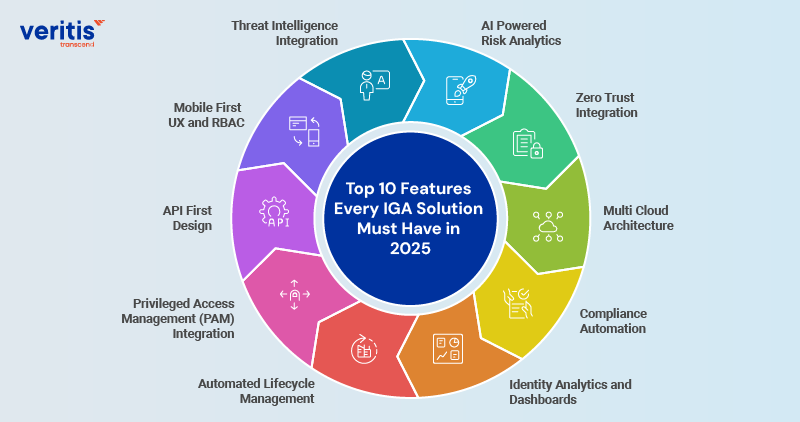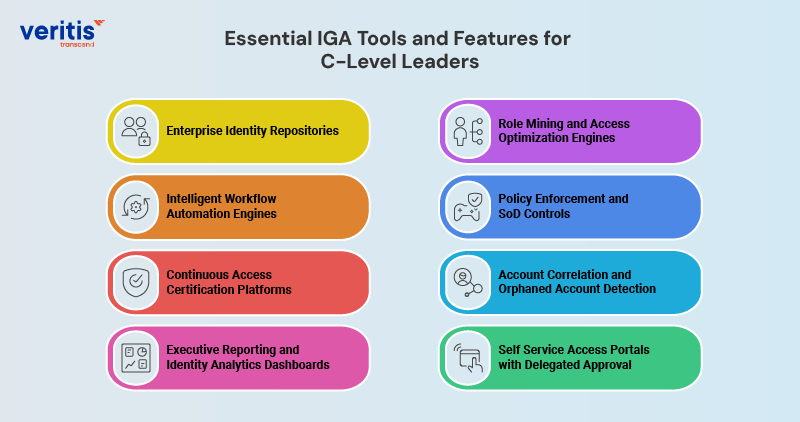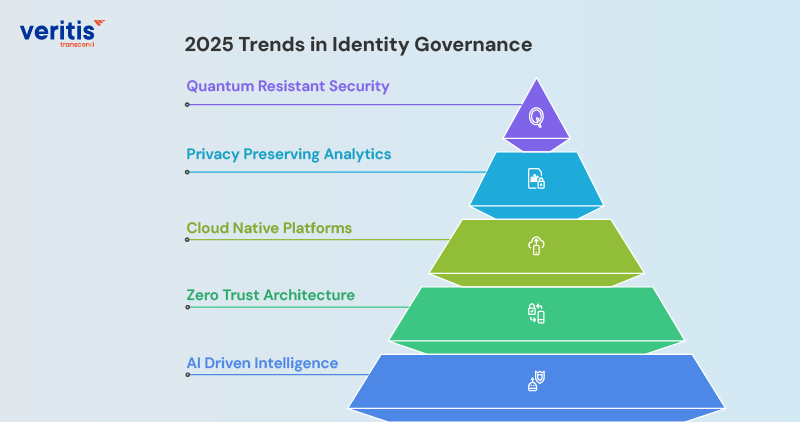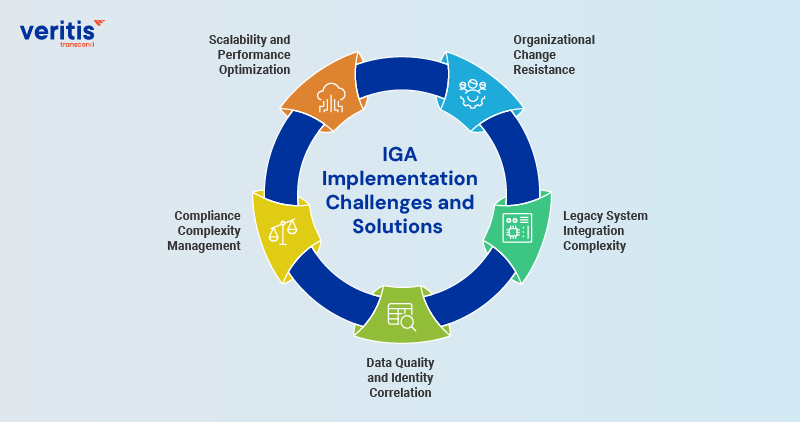
As of 2025, identity has become the new security perimeter. With 83% of data breaches involving compromised credentials and average breach costs reaching $4.88 million, C-suite executives can no longer treat Identity Governance and Administration (IGA) as merely an IT concern; it’s a business critical investment that directly impacts enterprise valuation, regulatory compliance, and competitive positioning.
While you’re focused on quarterly earnings, cybercriminals are plotting your company’s digital downfall. In 2025, 83% of data breaches stem from compromised credentials, and the average cost? A staggering $4.88 million per breach.
- For CEOs and CISOs, IGA is a strategic risk insurance that safeguards brand, compliance, and enterprise value, as 83% of breaches involve compromised credentials.
- CIOs and CFOs report up to 312% ROI, $8M in annual savings, and 70% lower compliance costs by embedding IGA into operational strategy.
- IGA turns audit pain into boardroom confidence, enabling Zero Trust, continuous SOX/HIPAA/GDPR compliance, and faster time to market for the entire C-suite.
- Veritis delivers measurable value in 90 days, empowering CEOs, CISOs, and risk officers to govern smarter, reduce exposure, and scale securely.
Visionary CEOs are leveraging Identity Governance and Administration (IGA) as their secret edge in Enterprise Risk Management (ERM), transforming what used to be an IT expense into a competitive moat worth millions.
Schedule an IGA Risk Assessment
What is Identity Governance and Administration (IGA)?
What is identity governance and administration? Think of it as your company’s digital bouncer system on steroids.
While traditional identity and access management services check IDs at the door, identity governance and administration solutions act like a sophisticated intelligence network that knows:
- WHO has access to your crown jewels
- WHAT they can touch, modify, or steal
- WHY they have that access (and if they still need it)
- WHEN to revoke access before it becomes a liability
Identity governance and administration is all about turning digital risk into a competitive advantage. Modern identity and access governance frameworks serve as the strategic backbone for bulletproof Enterprise Risk Management (ERM) that boards understand.
Core Components of IGA
1) Identity Lifecycle Management
Imagine reducing employee onboarding time by 45% while eliminating 65% of those pesky “zombie accounts” that haunt your systems. Identity governance and administration solutions deliver automated provisioning, making your HR team appear like digital wizards. These identity lifecycle processes integrate seamlessly with existing IAM solutions, creating a seamless digital employee journey from day one to final logout.
2) Access Governance Framework
Here’s a boardroom worthy stat: Advanced access governance mechanisms deliver 40 to 60% improvement in regulatory compliance (SOX, HIPAA, GDPR, PCI DSS) audit outcomes while slashing security incidents by 50 to 75%. This is about insider threat prevention that protects your company’s most valuable assets while keeping auditors happy.
3) Policy Administration Engine
Stop burning cash on manual compliance processes. Modern policy enforcement engines maintain 99.5% policy compliance rates while reducing audit prep time by 65%. This is how forward thinking CEOs achieve audit readiness without the traditional headaches, supporting continuous compliance that scales with growth.
Useful Link: IAM Best Practices for Optimal Cloud Security
Strategic Benefits of IGA

1) Operational Excellence
Identity governance and administration implementations reduce access provisioning time by 50 to 70%, freeing your IT team to focus on revenue generating projects. Result? 85% fewer help desk tickets and $2.3 million average annual savings for mid sized enterprises. This operational risk reduction directly aligns with CISO priorities for efficiency and strategic value.
2) Risk Mitigation
Comprehensive identity and access governance reduces insider threat exposure by 60 to 80%. Mature implementations demonstrate a 75% decrease in privilege escalation incidents, resulting in $4.2 million annually in measurable risk mitigation through proactive threat prevention and advanced threat detection capabilities.
3) Compliance Automation
Transform regulatory compliance (SOX, HIPAA, GDPR, PCI DSS) from costly burden to competitive advantage. Organizations report a 70% reduction in compliance costs while achieving 95% faster regulatory reporting. This enhanced audit readiness supports robust governance frameworks across all business functions.
4) Business Agility
Enable 40% faster time to market for new initiatives while maintaining zero trust security standards. Self service capabilities reduce administrative overhead by 60%, enabling business units to operate with unprecedented autonomy while supporting intelligent risk based access decisions.
5) Financial Performance
Here’s the number that matters: 312% ROI within 24 months. Enterprises save $8.4 million annually through reduced breach probability, lower compliance costs, and improved operational efficiency. Cyber insurance premiums decrease by 25 to 35% with comprehensive governance frameworks that align with sophisticated risk officer strategies.
Top 10 Features Every IGA Solution Must Have in 2025

1) AI Powered Risk Analytics
Leverage machine learning to detect anomalous access patterns and predict threats before they occur. These analytics provide actionable intelligence that helps prioritize remediation and policy refinement.
2) Zero Trust Integration
Support adaptive, risk based access decisions as part of a Zero Trust architecture. IGA solutions must evaluate user context (location, device, and behavior) in real time to enforce least privilege principles.
3) Multi Cloud Architecture
Ensure consistent identity and access governance across AWS, Azure, Google Cloud, and hybrid environments. A centralized IGA security platform simplifies compliance and mitigates the risk of cloud sprawl.
4) Compliance Automation
Deliver out of the box controls mapped to SOX, HIPAA, GDPR, and PCI DSS. Automated policy enforcement and violation alerts reduce audit fatigue and accelerate certification readiness.
5) Identity Analytics and Dashboards
Enable CISOs and risk officers to make strategic decisions with real time dashboards, predictive modeling, and identity heatmaps that surface emerging governance risks.
6) Automated Lifecycle Management
Integrate with HR and ERP systems to dynamically provision and deprovision access based on employment status or role changes, reducing ghost accounts and insider risk.
7) Privileged Access Management (PAM) Integration
Monitor and control high risk accounts with session logging, just in time access, and elevated privilege alerts, ensuring tighter control over your most sensitive data and systems.
8) API First Design
Enable fast integration with IAM solutions, ticketing systems, SIEM, and other security tools through robust, open APIs, ensuring IGA security seamlessly fits into your broader cybersecurity ecosystem.
9) Mobile First UX and RBAC
Support anytime, anywhere governance through intuitive mobile interfaces. Empower users with self service access while maintaining security via role based access control.
10) Threat Intelligence Integration
Connect with threat intel platforms and SOAR systems to contextualize identity risks and automate incident response workflows, closing the loop between detection and mitigation.
Useful Link: The CISO Roadmap to Cloud Identity Management Excellence
Essential IGA Tools and Features for C-Level Leaders

1) Enterprise Identity Repositories
Serve as the authoritative source of user truth across all applications, departments, and geographies. Modern repositories maintain 99.9% uptime and real time sync across 500+ systems, ensuring accurate identity data for provisioning, compliance, and audit at scale.
2) Intelligent Workflow Automation Engines
Eliminate manual errors and accelerate access decisions by automating policy-driven approvals and exception handling. Top-tier engines handle over 10,000 access requests per day with sub-second response times, reducing operational overhead by 80% while enhancing user experience and improving SLA adherence.
3) Continuous Access Certification Platforms
Enable proactive governance by facilitating ongoing validation of user entitlements. These IGA tools improve manager engagement to 95% and reduce review cycles from quarterly to continuous, enhancing regulatory confidence and minimizing risk exposure.
4) Executive Reporting and Identity Analytics Dashboards
Provide real time insights into entitlements, risk hotspots, policy violations, and audit trails. Predictive analytics empower C-level decision-making, allowing security leaders to prioritize investments, reduce policy drift, and visualize their identity posture over time.
5) Role Mining and Access Optimization Engines
Analyze current access patterns to design and enforce efficient role structures that optimize access control. These IGA tools reduce over-provisioning by up to 70%, prevent access creep, and typically unlock $1M–$2M in annual savings through streamlined permission governance.
6) Policy Enforcement and SoD Controls
Ensure access decisions align with regulatory and business policies by dynamically enforcing segregation of duties (SoD), approval hierarchies, and risk scores. These tools mitigate fraud risk and simplify audit-readiness across complex enterprises.
7) Account Correlation and Orphaned Account Detection
Automatically identify and reconcile accounts across systems to eliminate orphaned and duplicate identities, which are crucial for preventing insider threats and ensuring accurate compliance.
8) Self Service Access Portals with Delegated Approval
Empower employees and managers with intuitive, mobile-friendly interfaces to request, approve, and manage access without IT bottlenecks, reducing IT workload and accelerating productivity.
Useful Link: Identity and Access Management Trends for 2025
Best Practices for IGA Implementation
1) Executive Sponsorship Strategy
C-suite leadership positions identity governance as a strategic business enabler rather than a tactical IT project. Organizations with executive sponsorship achieve 85% higher implementation success rates and 40% faster time to value.
2) Cross Functional Governance
Integrated committees, including legal, compliance, HR, and business units, create shared accountability. Cross functional approaches deliver 55% better user adoption and 65% improved policy compliance across enterprise environments.
3) Phased Deployment Methodology
Risk based implementation prioritizing high impact systems and user populations. Phased approaches demonstrate measurable value within 90 days while building organizational confidence and stakeholder support for broader initiatives.
4) Integration Architecture Planning
Seamless connectivity with existing security investments, maximizing ROI from the current technology stack. Strategic integration reduces implementation costs by 45% while accelerating time to value through leveraging existing capabilities.
5) Performance Metrics Framework
Clear KPIs, including provisioning time, audit costs, and incident reduction, enabling data driven optimization. Organizations with comprehensive metrics achieve 60% higher ROI and sustained executive support throughout the implementation lifecycle.
Industry Specific Use Cases
1) Financial Services
Wall Street leaders achieve 90% audit success rates while reducing compliance costs by $3.2 million annually by utilizing automated governance and enhancing audit readiness. Regulatory compliance (SOX, HIPAA, GDPR, PCI DSS) becomes a strategic differentiator, not a cost center.
2) Healthcare
Healthcare innovators report a 95% reduction in privacy violations while enabling emergency care through intelligent access controls. These organizations master HIPAA compliance within comprehensive regulatory compliance (SOX, HIPAA, GDPR, PCI DSS) frameworks.
3) Manufacturing
Manufacturing enterprises prevent IP theft worth $12 million annually while maintaining operational efficiency through integrated OT security and operational risk reduction via sophisticated privileged access control mechanisms.
4) Government
Government agencies achieve 99.8% compliance with security protocols while detecting potential insider threats 85% faster, thanks to advanced threat detection capabilities and comprehensive governance frameworks.
5) Technology
Tech companies reduce security vulnerabilities by 75% while accelerating release cycles through automated governance that supports zero trust security principles and streamlined identity and access management solutions.
2025 Trends in Identity Governance

1) AI Driven Intelligence
Machine learning algorithms deliver 70% improvement in threat detection accuracy while reducing false positives by 85%, supporting advanced risk based access decisions that keep you ahead of threats.
2) Zero Trust Architecture
Zero trust security integration reduces breach impact by 60% while improving user experience through intelligent access decisions aligned with modern enterprise security posture requirements.
3) Cloud Native Platforms
Modern identity and access management solutions reduce infrastructure costs by 55% while providing 99.99% availability and unlimited scalability for enterprise requirements.
4) Privacy Preserving Analytics
Advanced privacy techniques ensure regulatory compliance (SOX, HIPAA, GDPR, PCI DSS) while enabling business intelligence across identity datasets.
5) Quantum Resistant Security
Quantum resistant implementations future proof identity investments while ensuring long term security through advanced risk reduction strategies.
Useful Link: Robust Identity Management With 8-Point IAM Audit Checklist and IAM Strategy
IGA vs IAM: Strategic Differences
| Aspect | IAM | IGA |
| Primary Focus | Authentication & basic access | Governance, compliance & risk management |
| Scope | Identity verification & access control | Complete lifecycle & policy enforcement |
| Business Impact | Operational efficiency | Strategic risk reduction & compliance |
| Regulatory Support | Basic compliance capabilities | Comprehensive audit readiness |
| Risk Management | Reactive security measures | Proactive threat prevention |
| Analytics | Basic reporting | Advanced business intelligence |
| Policy Control | Application-specific rules | Enterprise-wide governance |
| Implementation ROI | 150-200% within 18 months | 300-400% within 24 months |
| Executive Visibility | IT operational metrics | Business risk indicators |
| Strategic Value | Foundation capability | Competitive differentiator |
AI Integration in IGA
1) Behavioral Analytics
Machine learning establishes baseline user activities and identifies anomalous patterns through sophisticated threat detection capabilities. 80% reduction in false positives while improving accuracy by 65%, supporting comprehensive insider threat prevention strategies.
2) Predictive Risk Scoring
AI powered assessment enables proactive remediation through advanced risk based access mechanisms. Predictive models prevent 75% of potential breaches through early intervention, enhancing overall enterprise security posture.
3) Intelligent Policy Optimization
Automated policy refinement delivers 45% improvement in access efficiency while reducing administrative overhead through dynamic policy enforcement and operational risk reduction.
4) Natural Language Processing
Advanced analytics identify policy violations and security risks 60% faster than traditional approaches, supporting enhanced audit readiness and continuous compliance.
5) Automated Decision Making
AI driven access decisions reduce manual processes by 70% while improving security through consistent policy enforcement and streamlined access governance.
IGA Implementation Challenges and Solutions

1) Organizational Change Resistance
Veritis Solution: Comprehensive change management with executive sponsorship and phased rollouts demonstrating immediate value aligned with security leadership objectives.
2) Legacy System Integration Complexity
Veritis Solution: Advanced integration frameworks with pre built connectors ensuring seamless connectivity through sophisticated IGA tools.
3) Data Quality and Identity Correlation
Veritis Solution: Intelligent data cleansing and automated correlation engines establish authoritative sources with 99.5% accuracy through comprehensive identity lifecycle management.
4) Compliance Complexity Management
Veritis Solution: Built-in compliance frameworks for regulatory compliance (SOX, HIPAA, GDPR, PCI DSS) with automated reporting and continuous compliance monitoring.
5) Scalability and Performance Optimization
Veritis Solution: Cloud native architectures providing elastic scalability through advanced identity and access management services.
Useful Link: What Are 12 Proven Best Practices Drive IAM Implementation Success?
How Veritis Helps Reduce Risk with IGA Solutions
1) Trusted by Fortune 500 Enterprises
Delivering identity governance transformation at scale across industries, including financial services, healthcare, manufacturing, energy, and government.
2) Strategic, Executive Aligned IGA Security Approach
Aligns identity governance with broader enterprise risk, compliance, and digital transformation priorities, ensuring board level visibility and buy in.
3) Rapid Value Realization Through Phased Implementation
Executes low risk, high impact deployments that reduce exposure immediately while scaling toward enterprise broad governance frameworks.
4) Measurable Risk Reduction
Clients report a 40–60% drop in identity related security incidents within six months, driven by automated controls, lifecycle enforcement, and privileged access governance.
5) Audit Ready Compliance Posture
Establishes continuous compliance with SOX, HIPAA, GDPR, and PCI DSS through policy enforcement, certification automation, and complete audit trails.
6) Quantifiable ROI and Operational Efficiency
- 50–70% reduction in access provisioning time
- 65% decrease in audit preparation costs
- 80% reduction in manual governance workload
Case Study: Streamlining Identity Governance for a Global Manufacturer
When a global manufacturing enterprise was struggling with a surge in identity governance challenges, including inconsistent access controls, delayed user deprovisioning, and increasing compliance pressure, they sought help from Veritis. Veritis responded with a centralized Identity and Access Management (IAM) framework, featuring role-based access control (RBAC), automated provisioning and revocation, and multi-factor authentication (MFA). This solution not only streamlined the client’s identity lifecycle management and minimized unauthorized access but also significantly enhanced audit readiness. The result was a more secure, compliant, and scalable identity governance model, enabling the organization to manage access across its complex, cloud-driven infrastructure with confidence.
The complete case study is available here: Manufacturing Firm Secured by Robust IAM Solution
Conclusion
Identity Governance and Administration solutions are no longer a compliance tool; they’re a core pillar of enterprise risk management. Organizations implementing IGA frameworks see up to 312% ROI, 60–80% fewer security incidents, and 70% lower compliance costs.
For C-suite leaders, the decision isn’t whether to, but how quickly you can operationalize identity governance to protect enterprise value, accelerate secure growth, and maintain regulatory confidence.
Veritis delivers complete IGA solutions that drive measurable business outcomes within 90 days. From rapid risk reduction to long term governance maturity, we help you transform identity governance into a strategic differentiator.
Build Resilience. Drive Growth. Govern Smarter with Veritis.
Contact us for a tailored IGA security risk assessment.